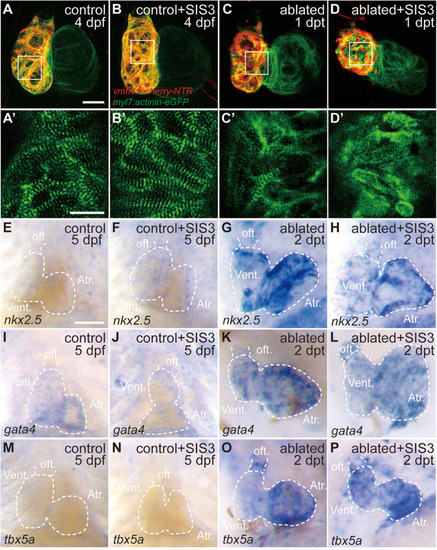- Title
-
Inhibition of TGF-β/Smad3 Signaling Disrupts Cardiomyocyte Cell Cycle Progression and Epithelial-Mesenchymal Transition-Like Response During Ventricle Regeneration
- Authors
- Peng, Y., Wang, W., Fang, Y., Hu, H., Chang, N., Pang, M., Hu, Y.F., Li, X., Long, H., Xiong, J.W., Zhang, R.
- Source
- Full text @ Front Cell Dev Biol
|
TGF-β/Smad3 signaling is activated during zebrafish ventricular regeneration. |
|
Inhibition of TGF-β/Smad3 signaling pathway impedes ventricular regeneration. |
|
Smad3 inhibition has limited effects on sarcomere disassembly and cardiogenic factor reactivation during regeneration. (A–D′) Representative fluorescence images of Tg(vmhc:mCherry-NTR; myl7:actinin-eGFP) hearts at 4 dpf/1 dpt indicate that sarcomere disassembly occurred in the ablated hearts (C,C′) and SIS3-treated ablated hearts (D,D′). (A′–D′) Enlargement of box areas in panels (A–D), green channel only. (E–P) Whole-mount in situ hybridization showing the expression level changes of cardiogenic factors nkx2.5, gata4, and tbx5a during regeneration. Smad3 inhibition via SIS3 treatment could abolish the reactivation of nkx2.5 at 5 dpf/2 dpt (G,H) but has no effect on the reactivation of gata4 and tbx5a (K,L,O,P). Dashed lines outline the hearts. Scale bars (A–D,E–P) 50 μm and (A′–D′) 20 μm. dpf, days post-fertilization; dpt, days post-treatment; atr., atrium; oft., out flow tract; vent., ventricle. |
|
Smad3 inhibition affects CM proliferation during regeneration. |
|
Smad3 inhibition reduces |
|
Smad3 inhibition affects |






